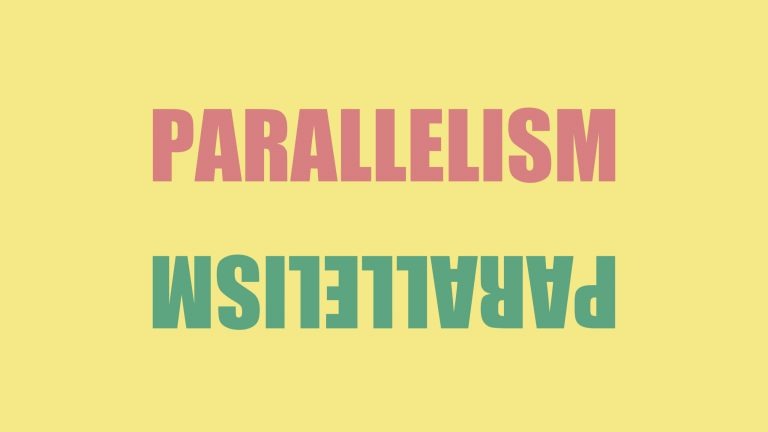
IELTS Grammar: Parallelism
Hey! In today’s blog I want to look at a grammar point that is not discussed very often but can make a big difference to your Grammatical Range and Accuracy score: parallelism. This is particularly true for high-level students who often make mistakes in this area. So, let’s start with the obvious question: What is parallelism? 🤔
Parallelism is making sure that the words you write in a list, or in a sentence that compares or contrasts, follow the same grammatical pattern.
The easiest type of parallelism to understand happens in lists. Look at this sentence (I have underlined the list):
Successful people tend to plan their day, working long hours, and they never give up.
Can you see the problem? In our list, we have three different types of grammar structure: an infinitive (to plan), a gerund (working), and a full clause (they never give up).
Successful people tend to plan their day, working long hours, and they never give up.
This is the opposite of parallelism! To improve this list, we need to change everything to the SAME FORM. And that means making sure that everything matches the FIRST ITEM in the list.
Successful people tend to plan their day, work long hours, and never give up.
That’s it – that is all parallelism is – making sure everything is the SAME. Now, here, we needed everything in our list to be an infinitive because that is what we use after “tend to”. However, in some lists we might want to use nouns:
The government should introduce more buses, trams and, late-night trains to encourage people to use more public transport. (Note here that we use the plural nouns to talk in general – you can find out more about this in my free Articles lesson)
In other lists we might want gerunds:
I am really looking forward to spending time with my family, eating fish and chips, and watching British TV when I go home later this year.
The point is that it doesn’t matter what type of words we are joining in a list, what is important is that all of the words have the same form as the first item. (And, if you want to know more about using commas in lists, you can go and complete my IELTS comma lesson when you finish this!)
Looking for help with IELTS grammar? We have a dedicated 10-hour course that is specifically designed to show you the structures needed for a 7.0+ Click here to watch the first three lessons for free.
Parallelism with Coordinating Conjunctions: and/but/or
Now, lists are the easiest type of parallelism – I hope that everybody reading this already uses the same form of word when they write one. However, things become more complicated when we join words/clauses with “and”, “but”, or “or”. This is because when sentences are longer, it can be easy to forget which form of the word you used in the first clause. Take this sentence for example:
This is because carbon dioxide helps to trap the heat in the atmosphere and making the earth’s temperature rise at a great rate.
Can you see the problem here? We have TWO clauses joined with “and”, but the first starts with the present simple “helps”, and the second starts with the gerund “making”. This mistake is harder to spot because there is quite a long distance between the two words! However, we still need parallelism here:
This is because carbon dioxide helps to trap the heat in the atmosphere and makes the earth’s temperature rise at a great rate.
This is the mistake that I see most often and the one that can bring a very high-leave student down from an 8.0 to a 7.0. If you are a strong student who finishes your essays early, add parallelism to your list of things to check for (along with subject / verb agreement)
Parallelism with Paired Conjunctions
There are also more complex structures that use parallelism. These are called “paired conjunctions” and this is when we use TWO WORDS to join clauses. And, guess what? Those clauses must have the SAME FORM!
| Paired Conjunctions | Example Sentence |
|---|---|
| both / and | I ate both the chicken and the fish. |
| either / or | Students often drop out of university because they are either stressed or burned-out. |
| neither / nor | Multi-national companies neither generate jobs nor pay a fair wage, so they have definitely not improved people’s quality of life. |
| not only / but also | The government should introduce a carbon tax not only to reduce the current consumption of fossil fuels but also to encourage future industry to move to alternative sources of energy. |
You can find out more about paired conjunctions in my free Introduction to Complex Sentences lesson. But, all you need to remember from today’s lesson is that paired conjunctions must always join words of the same form.
Let’s do some practice! 🏋️♀️
So, now we know what parallelism is, let’s see if you can spot it! Here are some real sentences taken from my students’ essays over the last few weeks. Each contains at least “one problem with parallelism” (that would be a good band name 🎸) – see if you can find and correct them:
- First of all, pursuing a career they are genuinely interested in would make students more satisfied and lower tension, as the chances to lose interest or getting into bad habits is lower.
- As large and industrial cities already suffer from poor air quality because of traffic fumes and air is contaminated with carbon emissions.
- Factories emit toxic gases into the air, which destroys the ozone layer and also causing air pollution.
- Before being ready for sale, the final set of stages include a quality check, packaging and storage of the product.
How did you get on? Here are the correct answers. Notice how sometimes we have to change quite a lot of the sentence to get the parallelism correct.
- First of all, pursuing a career they are genuinely interested in would make students more satisfied and less tense, as the chances to lose interest or to get into bad habits is lower. (It would be better to change the 2nd mistake to “the chances of losing interest or getting into bad habits is lower)
- As large and industrial cities already suffer from poor air quality because of traffic fumes and carbon emissions.
- Factories emit toxic gases into the air, which destroys the ozone layer and also causes air pollution.
- Before being ready for sale, the final set of stages include checking for quality, packaging and storing the product.

